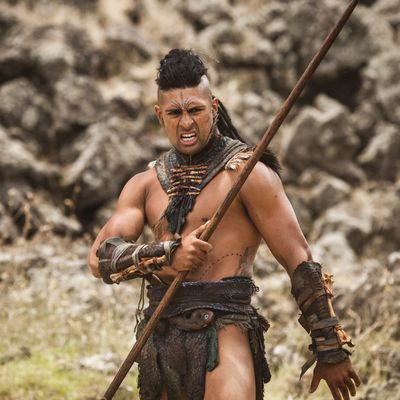
Toa FraserÔÇÖs Maori thriller The Dead Lands is a solid entry in the loose subgenre we might call the ÔÇ£ethnographic action filmÔÇØ ÔÇö earlier examples of which include Mel GibsonÔÇÖs Apocalypto or Zacarias KunukÔÇÖs Atanarjuat; The Fast Runner or Kevin ReynoldsÔÇÖs Rapa Nui. In these movies, which vary dramatically in tone and quality, basic action tropes are recycled, and in some cases revitalized, as weÔÇÖre immersed in remote, sometimes extinct, native cultures. Primal tales of vengeance or pursuit or loyalty gain mythic power through the sheer novelty of context. ThatÔÇÖs the idea, anyway. Sometimes, the setting is just a crutch.
You wonÔÇÖt necessarily learn all that much about Maori culture while watching The Dead Lands, which is set in a pre-colonial stretch of wilderness thick with forests, mountains, and caves ÔÇö all beautifully shot by Leon Narbey. Fraser himself is a half-Fijian director who works out of New Zealand, and his work is diverse: He also made the gentle, dog-friendly 2008 drama Dean Spanley, which features one of Peter OÔÇÖTooleÔÇÖs great, final performances. That film and this one have absolutely nothing to do with each other, besides the fact that they both sport simple, fablelike premises that even a child could grasp.
In The Dead Lands, a group of warriors led by chieftainÔÇÖs son Wirepa (Te Kohe Tuhaka) wipes out a rival tribe under the pretext that their ancestorsÔÇÖ remains have been desecrated. The only male survivor, Hongi (James Rolleston), himself a chieftainÔÇÖs son, misses the battle and vows revenge. As he pursues his clanÔÇÖs murderers, he enters a forbidden zone known as the Dead Lands, so called for a tribe that went mysteriously missing there many moons ago. The area, weÔÇÖre told, is haunted by an un-kill-able demon. Hongi discovers that the demon is in fact merely a lone, powerful warrior (Lawrence Makoare), who is himself tormented by a ghastly memory of loss.
The two join forces, and the warrior teaches the boy how to fight. ItÔÇÖs a novice-mentor relationship not unlike the ones weÔÇÖve seen in countless other Hollywood movies; and as always, the mentor is in need of some redemption himself. Most of The Dead Lands, in fact, adheres to a fairly simple action film template. But the dynamic between the characters works because Fraser keeps it tough. This is not a cuddly, misunderstood demon-warrior weÔÇÖre talking about here; the deeds he needs to live down are truly abominable.
Similarly, the fight scenes in the film are intense, close, and bloody. The warriors use spears and patu, a kind of traditional paddlelike weapon that nevertheless seems insanely deadly. The fighting is punctuated by ritualistic sneering and bellowing and jumping ÔÇö gestures designed to terrify oneÔÇÖs opponents ÔÇö that are so ubiquitous as to become their own language. These warriors communicate through grimaces, shouts, and stomps more than they do through words. The effect is unnerving, and, in its own way, beautiful.
All these nods to tradition and mythology ÔÇö there are also extended moments where Hongi communes with his dead ancestors ÔÇö give The Dead Lands a unique, otherworldly atmosphere. But for all that, the filmÔÇÖs chief appeal lies in a certain streamlined quality. It feels like a typical action movie thatÔÇÖs been sawed off and sanded down ÔÇö its blunt edges sharpened, its soft center drained out. ItÔÇÖs not particularly original, but it is mean, relentless, and bracing.


